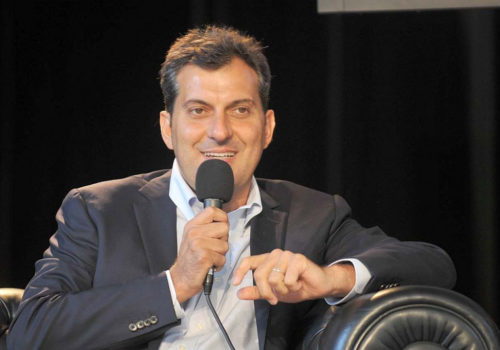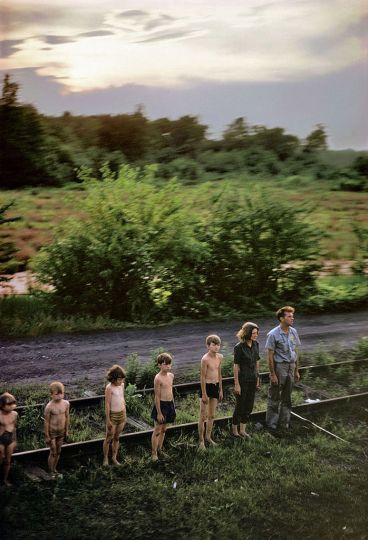“Seeing things is at the core of journalism, so I think this exhibition deals with journalism too. It’s about the essence of journalism, to be on the spot, being able to think ahead, to see what’s happening in the world, trying to understand it and to witness it. Photographers help us to understand” says Mario Calabresi, editor-in-chief of the Italian daily La Stampa, and the author of the book the exhibit is based on. More than one hundred photographs , you can look at them as a captivating journey illustrated by Calabresi’s words.
He has always been keen on photography, and interested in journalism. So he had to know how some of the most well known photographers managed to approach reality, framing some extraordinary moments of our time with a series of images taken with their eyes open onto the world. He wanted to know the stories behind the shots which managed to form our collective consciousness. And he wanted to understand if their authors realized that they were capturing a moment that would go down in history.
Mario Calabresi’s research started with these questions. The answers are in the words and in the images of ten masters of photography, they tell of their commitment with history and of a never forgotten sense of ethics and humanity.As when Don McCullin realized the soldiers he had just photographed were at a a sniper’s gunpoint: he suddenly dropped his camera and shouted to warn them. Or when in a surreal dialogue Josef Koudelka, as the young “anonymous P. P. (Prague Photographer)” said, “I photographed Russians” and his father answered: “It would be better then to go and photograph abroad”. You can experience all this also through the images of Abbas, Gabriele Basilico, Elliott Erwitt, Paul Fusco, Steve McCurry, Paolo Pellegrin, Sebastião Salgado and Alex Webb.
Do photography and journalism have something in common?
“While I was writing the book, Domenico Quirico, war correspondent for La Stampa, was imprisoned in Syria. The obvious question was what it is like to be a journalist? Photographers, and journalists, have to be on the spot: they have to tell about what they see, they must understand what’s going on and synthesize it into a picture. Journalists have to work as straight reporters, looking at the facts. As Quirico says, we cannot stay on the edge of a well, observing and describing the surface.
How were the photos selected?
“First I thought of the photographers I like the most, those whose photos give me a sense of history. Important pictures are not extemporary, instead they are the result of work and method. The exhibit was planned with the photographers, to show picture which are symbolic, witnessing a piece of history and thus becoming keys to an interpretation of historical moments. But I also asked each author to let me (and all of us) understand which pictures were the most distinctive in their own working path, the ones they thought have really crossed history. Each author’s pictures are on display in their own show-room. And captions from the book are under the photos, phrases I’ve collected from the photographers: as the book turned into a show, we’ve undergone an interesting experiment of transposition.
These photos speak for themselves: what is the added value of texts?
I think photographs have a communication immediacy that written words have not, but they are complementary, for texts can tell us about the contexts in which the facts developed.
Do you think photojournalism has been taken a bit “too much for granted” in the last few years?
I don’t think there was a golden age when photography was grasped by everyone, even in the past it was intended for a small group of people. Great photography has always been there and so it will always be. I feel really strongly about this: and whenever possible I commission reportages for the newspaper (i.e. Pietro Masturzo, who won the World Press Photo 2009, was commissioned for a reportage on the European elections campaign in 2014) and acquire major works (i.e. the Amazon by Salgado). By the way, Italy has got a remarkable number of very good young photographers and we have to give them credit .
With the transition from analogic to digital photography it has been thought that everyone could get into photography. Today it seems there is a new knowledge of “good” images.
Let’s say the storm is over concerning the idea that everyone could do everything. “ Open Eyes”, says photography, as well as journalism, is a profession and therefore it requires the investment of our best energies and resources. Any of us, me too, may find ourselves involved in an important event: we can shoot a picture with our smartphones (this is the difference with the past). But we would shoot it, because we are there only by chance.
How does a photographer figure out history paths and how can he cross them?
He has to study. For instance, Abbas went to Iran, where in my opinion he did “the” work on the Iranian revolution. He went there to record the clash between two Iran, the one influenced by Western secular models and the one of those who felt the Shah’s regime oppressive and were looking towards a return to traditionalist values. He was there to deal with these two worlds but he also felt and he knew that something was going to happen in that very moment in that geographical area and he was already there when the tensions broke and the revolution arose. He managed to anticipate the event.
Which key elements turn a photo in an historical document?
They are the ones who allow to perfectly represent a moment of transition, of variance. The photo Erwitt shot at John Kennedy’s funeral, Jacqueline in tears and Bob, his head bowed, with the folded flag on his arms, for instance. That picture made clear to anyone that the Kennedy dream was over.
Where does your passion for photography comes from?
My mother’s younger brother Attilio used to be a fashion photographer and, when I was a kid, I often went to his studio. He had lots of books and photography magazines there: I read them all. My uncle used to “force” me to visit exhibitions. Then my adoptive father, Tonino Milite, who is an artist, also used to shoot a lot. I still remember when, a long time ago, we went together to some villages in Southern Italy, where he took so many portraits featuring elderly people. Then I received a Russian camera as a gift, so I started shooting pictures. As I was introduced to good photos, I suddenly realized that photography was something different, so I stopped taking pictures and started to collect photos. The first one I bought was by a Russian photographer; the first “important” one was by Alex Webb. Then, especially during the three years I lived in New York, I saw all that could be seen on photography, I started hanging out at Magnum, buying books and filling my house with them.
How can the photographer objectivity and commitment be balanced? How can a photographer tell his own story, though in an objective way?
Like the ones in the exhibit, photojournalists are fond of their work, but above all of witnessing facts and reality. I learned a quite interesting lesson on journalism from these photographers, on “being on the spot”, on the method, on the talent of witnessing history looking at all the facts, on the perseverance needed for it, on the ethical sense they used.
Why is ” With Open Eyes” a different exhibit?
You can visit it through a multifaceted process of reading and interpreting it. For instance you can follow a path, widely accessible to everyone, which allow you to meet ten well recognized photographers and to be acquainted with their work. Their impressive images can even let “non-expert” understand better photography. Then there’s another path, a more complex one in my opinion, which follows the thread I put in the book, which is the receptive capability all these photographers have to witness history, to grab moments and facts.
Biography
Mario Calabresi, 44, writer and journalist, has been Editor-in-Chief of La Stampa since April 2009. He studied History and journalism, then used to work as a political reporter for the ANSA news agency. He was hired by the daily newspaper La Repubblica, and then La Stampa. In 2002, he was Managing Editor of La Repubblica and in 2007, he went to the United States to cover the US presidential campaign as New York correspondent. He also won several awards for journalism. “A occhi aperti” is his fourth book; his first one was an autobiography “Spingendo la notte più in là” (Pushing past the night), a book about his own family and other victims of terrorism, which dealt with his father death (Luigi Calabresi was killed in 1972 by terrorists)
EXHIBITION
A occhi aperti – (With Open Eyes)
When history was caught in a photo
Abbas, Gabriele Basilico, Elliott Erwitt, Paul Fusco, Don McCullin, Steve McCurry, Josef Koudelka, Paolo Pellegrin, Sebastião Salgado, Alex Webb
Until February 8th 2015
Reggia di Venaria, Rooms of the Arts
Piazza della Repubblica 4
10078 Venaria Reale (Turin)
Italy
Tuesday to Friday: 10.00am – 6.00pm
Saturday, Sunday and holidays: 9.30am – 7.30pm.
http://www.lavenaria.it

















